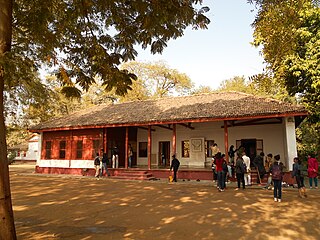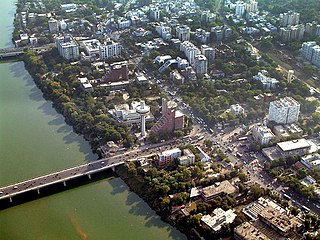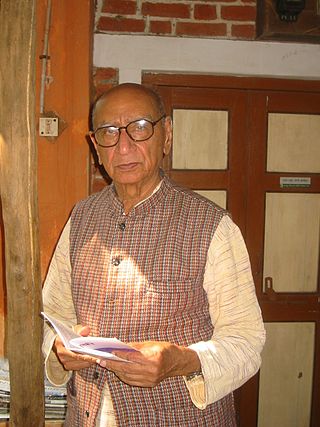
Mahadev Haribhai Desai was an Indian independence activist, scholar and writer best remembered as Mahatma Gandhi's personal secretary. He has variously been described as "Gandhi's Boswell, a Plato to Gandhi's Socrates, as well as an Ānanda to Gandhi's Buddha".

Kasturba Mohandas Gandhi was an Indian political activist who was involved in the Indian independence movement during British India. She was married to Mohandas Karamchand Gandhi, commonly known as Mahatma Gandhi. National Safe Motherhood Day is observed in India annually on April 11, coinciding with Kasturba's birthday.

Sabarmati Ashram is located in the Sabarmati suburb of Ahmedabad, Gujarat, adjoining the Ashram Road, on the banks of the River Sabarmati, 4 miles (6.4 km) from the town hall. This was one of the many residences of Mahatma Gandhi who lived at Sabarmati (Gujarat) and Sevagram when he was not travelling across India or in prison. He lived in Sabarmati or Wardha for a total of twelve years with his wife Kasturba Gandhi and followers, including Vinoba Bhave. The Bhagavad Gita was recited here daily as part of the Ashram schedule.

Sevagram is a town in the state of Maharashtra, India. It was the place of Mahatma Gandhi's ashram and his residence from 1936 to his death in 1948. After Sabarmati, Sevagram Ashram holds immense importance due to the residence of Mahatma Gandhi.

Kaba Gandhi No Delo is a house and a museum in Rajkot, Gujarat, India. It was Indian independence leader Mahatma Gandhi's primary family home from 1881 to 1915. It is built in the traditional Saurashtrian architectural style and houses a permanent pictorial exhibition called Gandhi Smriti.

Madeleine Slade, also known as Mirabehn or Meera Behn, was a British supporter of the Indian Independence Movement who in the 1920s left her home in England to live and work with Mahatma Gandhi. She devoted her life to human development and the advancement of Gandhi's principles.
Narhari Dwarkadas Parikh was a writer, independence activist and social reformer from Gujarat, India. Influenced by Mahatma Gandhi, he was associated with Gandhian institutes throughout his life. He wrote biographies, edited works by associates and translated some works. His writing also reflected Gandhian influence.

Gujarat Vidyapith is a deemed university in Ahmedabad, Gujarat, India. This institute was founded in 1920 by Mahatma Gandhi, India's "Father of the Nation" and the leader of the Indian independence movement. It has been deemed university since 1963.

Ahmedabad is located on the banks of the River Sabarmati in the northern part of Gujarat and the western part of India. It is located at 23.03°N 72.58°E spanning an area of 550 km2. The average elevation is 53 metres.

Narayan Desai was an Indian Gandhian and author.

Dattatreya Balkrishna Kalelkar, popularly known as Kaka Kalelkar, was an Indian independence activist, social reformer, journalist and an eminent follower of the philosophy and methods of Mahatma Gandhi.

Maniben Patel was an Indian independence movement activist and a Member of the Indian parliament. She was the daughter of freedom fighter and post-Independence Indian leader Sardar Vallabhbhai Patel. Educated in Bombay, Patel adopted the teachings of Mahatma Gandhi in 1918, and started working regularly at his ashram in Ahmedabad.

Jugatram Chimanlal Dave (1892–1985) was a Gandhian social activist, freedom fighter and author from Gujarat, India who is remembered for his social work among the tribals of southern Gujarat.
Kanu Gandhi was an Indian photographer. He was a grandnephew of Mahatma Gandhi who lived with him in several of his ashrams and was a member of his personal staff. He is best remembered as Gandhi's photographer, recording many moments of Gandhi's life on film from 1938 until his assassination in 1948. Following Gandhi's death, Kanu and his wife Abha moved to Rajkot where they ran a rural centre named after Kasturba Gandhi. Abha was one of the companions with Gandhi at Birla House Delhi, when Godse shot Gandhi.

The online Gandhi Heritage Portal preserves, protects, and disseminates original writings of Mohandas K. Gandhi and makes available to the world the large corpus of "Fundamental Works" which are useful for any comprehensive study of the life and thought of Gandhiji. Gandhiji was 24 years old in South Africa "Natal Indian Congress " made in 1894.

Mithuben Hormusji Petit was an Indian independence activist who participated in Mahatma Gandhi's Dandi March. A pioneer female independence activist, she was the Secretary of the Rashtriya Stree Sabha, a women's movement founded on Gandhian ideals. She became a recipient of India’s fourth highest-civilian honour, Padma Shri in 1961, for her social work.
Zohraben Akbarbhai Chavda (1923–1997) was a Gandhian social reformer and member of the 3rd Lok Sabha from Banaskantha.
Kishorlal Ghanshyamlal Mashruwala was an Indian independence activist as well as biographer, essayist and translator. Educated in Bombay and Agra, he completed BA and LLB. He was an associate of Mahatma Gandhi and was deeply influenced by him. He extensively wrote on education, religion and philosophy as well as translated some works in Gujarati.
Dinkar Krishnalal Mehta was an Indian politician and trade unionist. Mehta headed the communist movement in Gujarat for decades – leading the Gujarat state unit of the Communist Party of India between 1936 and 1964, and then the Communist Party of India (Marxist) between 1964 and 1989. He served as a legislator of Bombay State and Mayor of Ahmedabad. Mehta was a prominent leader of the Mahagujarat movement, which struggled for the creation of a Gujarati linguistic state.
Prabhudas Gandhi was an Indian Gujarati language writer and translator. He was a son of Mahatma Gandhi's nephew Chhaganlal Gandhi. He was awarded the Narmad Suvarna Chandrak (1948) for his book Jivannu Parodh..















